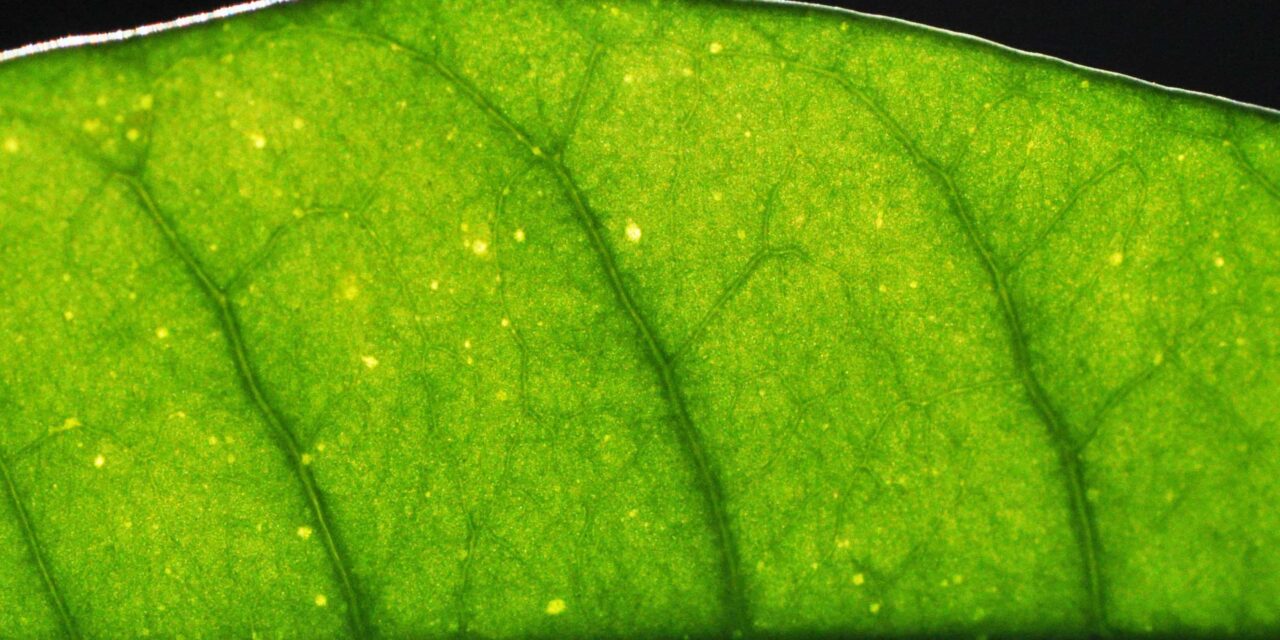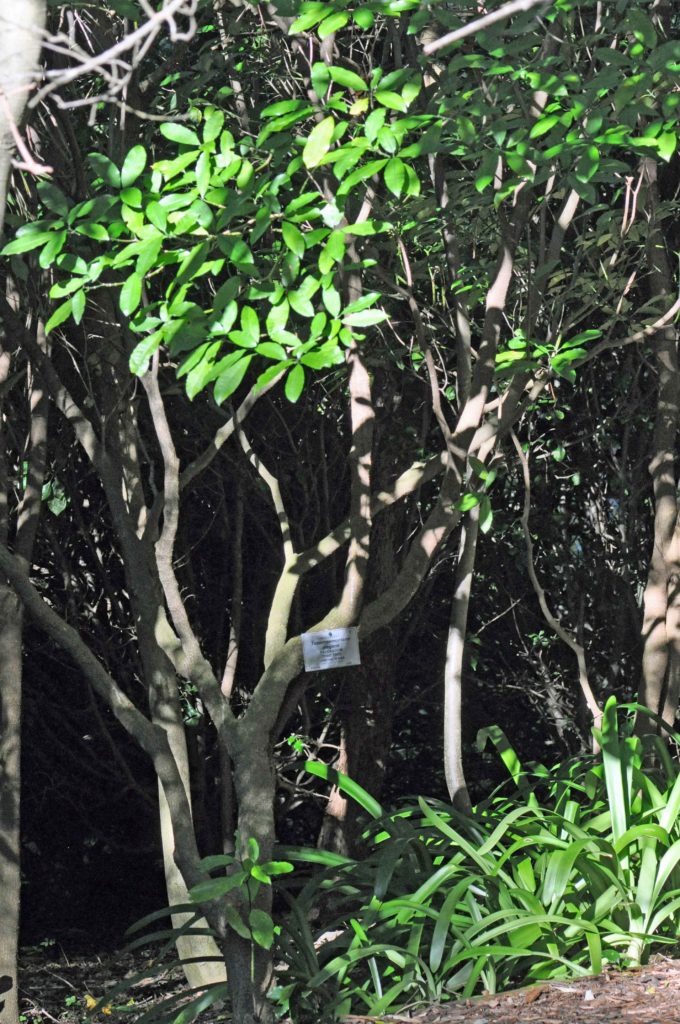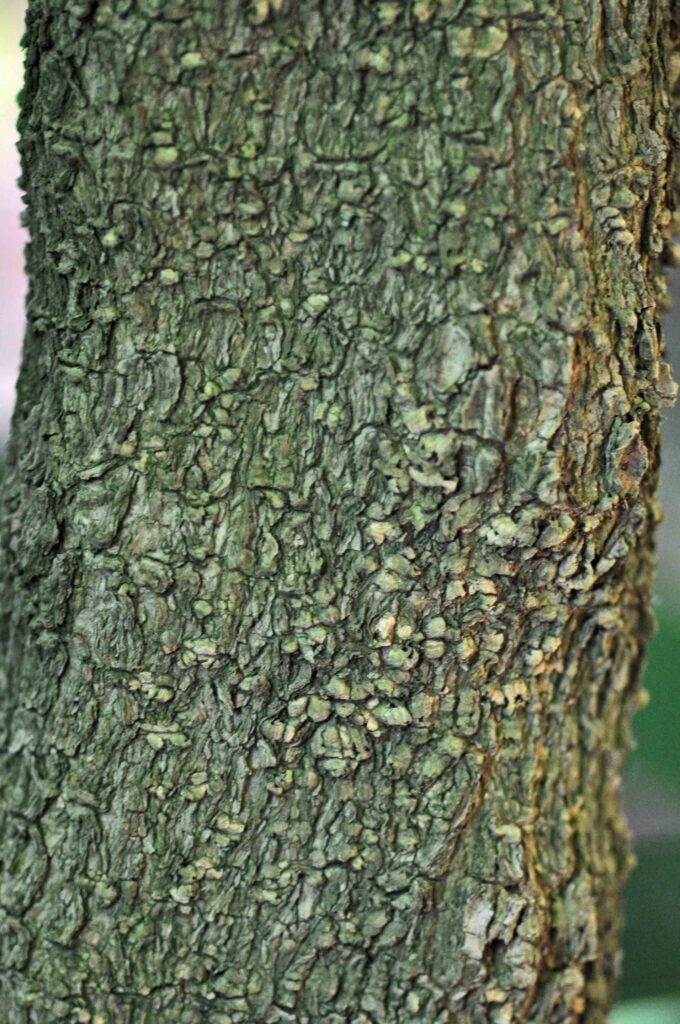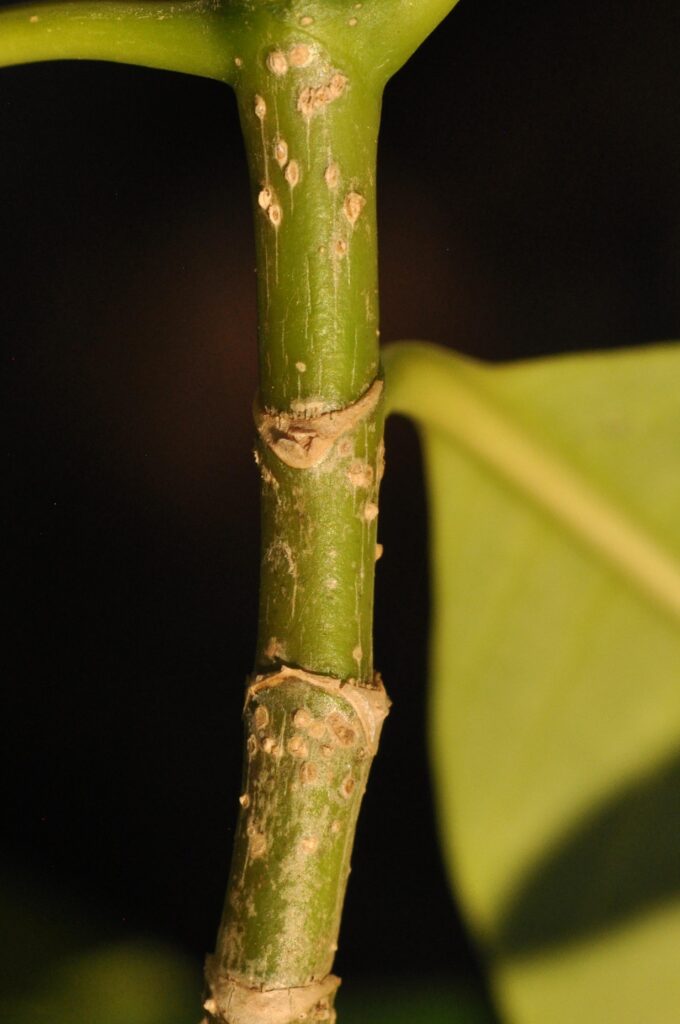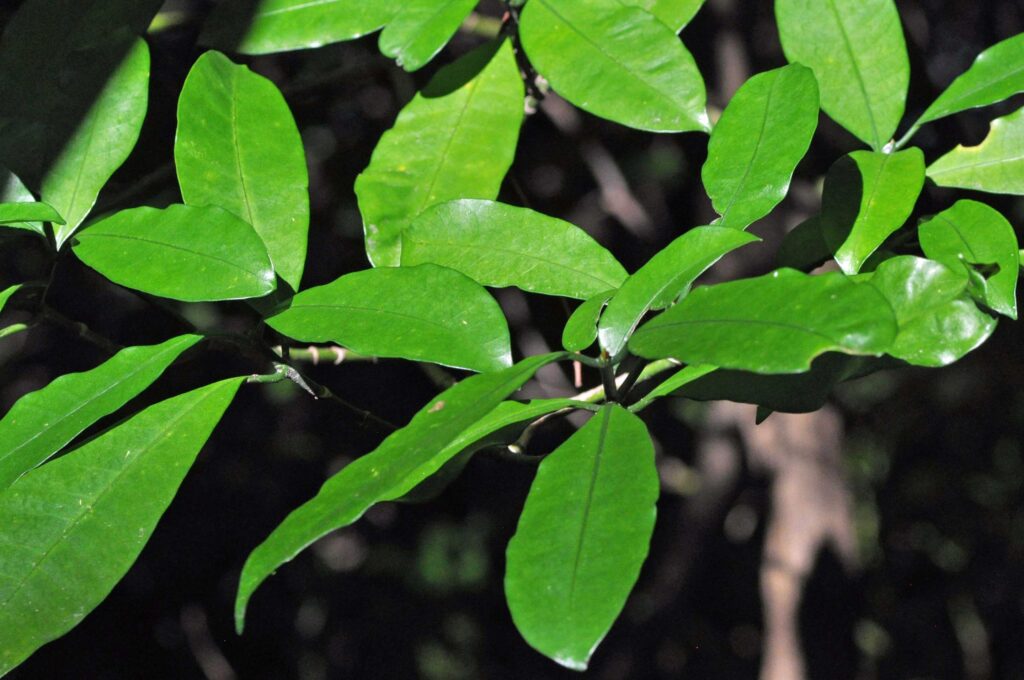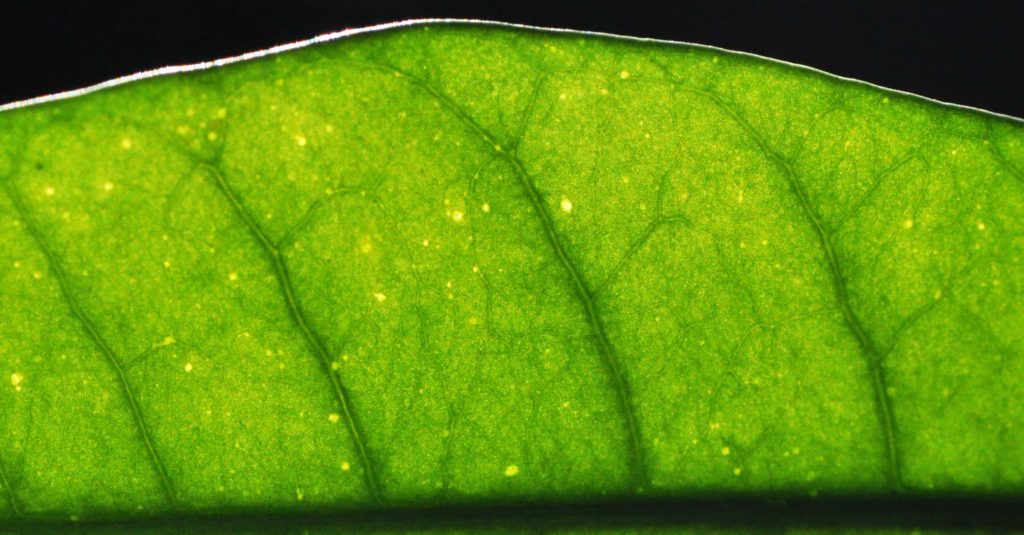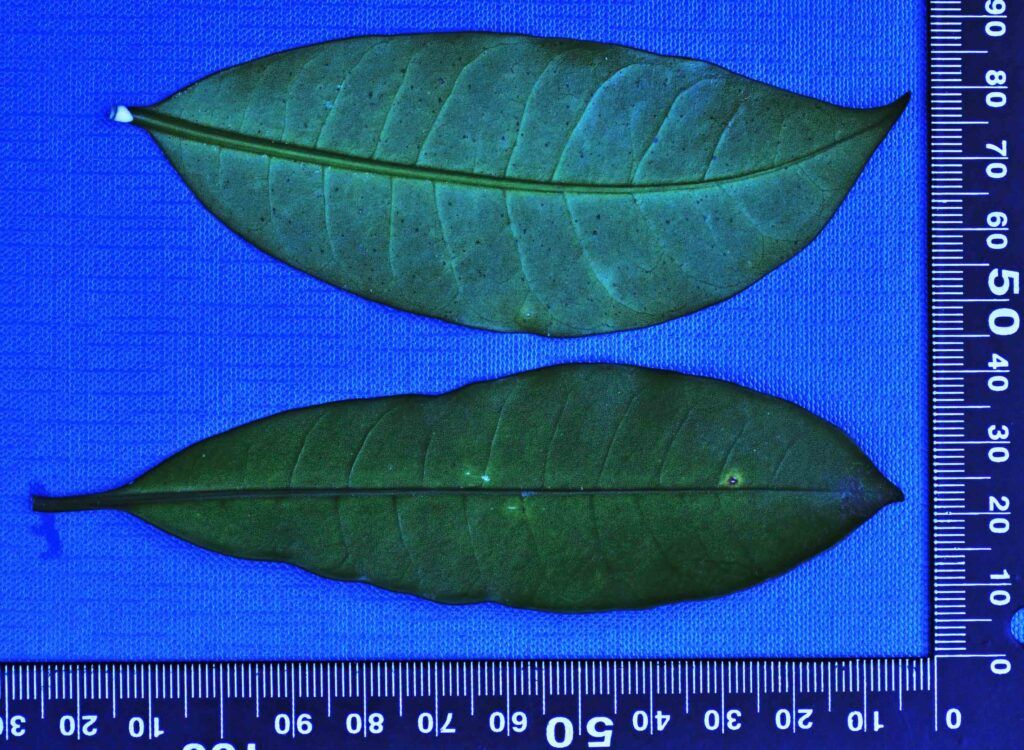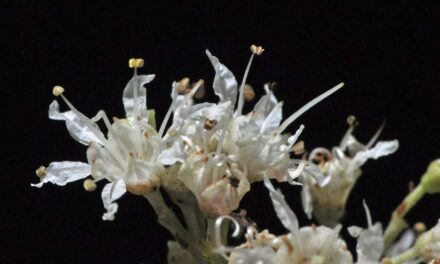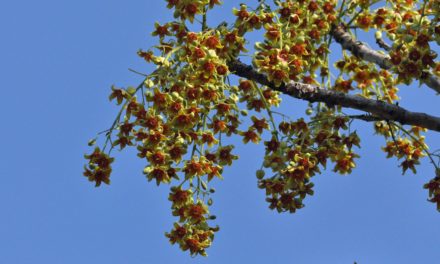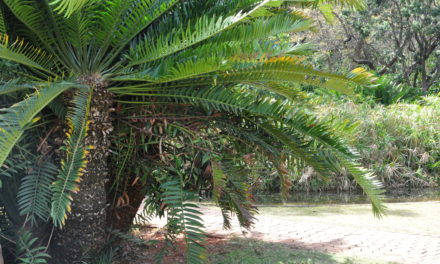General Info – summary
Attractive spineless shrub/Tree to 9m high has grey, corky bark & milky sap. Opposite, glossy, hairless & simple Leaves have wavy entire margins. Stipules form an ocrea. 5-merous, bisexual, regular & trumpet shaped Flowers in a corymb. Ovate green sepals surround whitish petals. 4-locular anthers have short filaments. Superior ovary has 2 free carpels & a cylindrical style. Fruit: 2 follicles & many grooved seeds.
Description
Tabernaemontana elegans
Previous Names: Conopharyngia elegans.
SA Tree No. 644.
Common names: (Afr) Laeveldse paddaboom, Paddaboom. (Eng) Toad Tree, Warty Toad-tree. (Setswana) Nkahlwane. (siSwati) Mkhahlu, Umfomamasi, Umkhahlu, Umkhamamasi. (Tshivenda) Muhatu. (isiZulu) Inomfi, Umkhadlu, Umkhahlu, Umkhahlwana.
Family: Apocynaceae: (Oleander or impala lily: Adenium multiflorum family). This family includes the exotic genera Oleander and Plumeria (Frangipani). Indigenous genera containing trees on this site include Acokanthera, Adenium, Carissa, Rauvolfia and Tabernaemontana. Currently the family has 366 genera and in excess of 5 000 species. In South Africa, there are 90 genera and about 700 species. All have milky or clear sap. The simple, entire and pinnately veined Leaves are usually opposite and may have stipules situated between the petiole and the stem. The Inflorescence is usually a cyme (a broad, more or less flat-topped, determinate flower cluster, with central flowers opening first). The regular and bisexual Flowers are usually bracteate. The Calyx has 4-5, usually free sepals and the 4-5 Petals are joined – at least at the base of the staminal column. A corona (an extension) is often present either on the corolla, or on arising from the base of the staminal column. The 4-5 Stamens are variously located and have anthers with 2 pollen sacs. The superior to half-inferior Ovary has 2 carpels. Fruit is various. The often-compressed Seeds may have a tuft of silky hair at the micropylar end. (The micropyle is a small opening in the surface of an ovule, through which the pollen tube penetrates, often visible as a small pore in the ripe seed. During germination, the seedling’s radicle – embryonic root – emerges through the micropyle).
Name derivation: Tabernaemontana – Named after Jacob Theodore Muller of Bergzabern, Hidelburg (1520-1590). He Latinized his hometown name: Bergzabern to Tabernaemontana. He was a physician and herbalist. elegans refers to the attractive appearance of the tree.
Conservation Status: L C (Least Concern). Assessed: 2005 (W. Foden & L. Potter).
Tree
The spineless, wide-spreading, deciduous or nearly so shrub or Tree with its rounded crown may reach 9m high. The usually single Stem (trunk, is main axis of the plant, the leaf and flower bearing as distinguished from the root-bearing axis) has a diameter of up to 30cm. The trees may have repeatedly dichotomous branches. The thickly corky rough Bark is greyish to light brown and develops longitudinal deep fissures when mature (photo 365). These fissures have a creamy-orange underbark. The smooth, hairless Branches occur low down (photo 363). Hairless Branchlets (usually applied to branches of the current or preceding year) are dark green and have visible leaf scars as well as scars that form from fallen stipules (photo 126). In this photo, lenticels (usually raised corky oval or elongated area on the plant that allows the uncontrolled interchange of gases with the environment) are clearly visible. A milky sap is present on all parts.
- 363. 2018/09/11 Kirstenbosch NBG. Photo: David Becking.
- 365. 2018/09/11 Kirstenbosch NBG. Photo: David Becking.
- 126. 2019/08/12 Skukuza nursery. Photo: David Becking.
Leaves
This tree is often deciduous. Leaves are simple (have a single blade, which may have incisions that are not deep enough to divide the leaf into leaflets), opposite, dark green, hairless, thinly leathery and glossy above. Leaves are a lighter green on the lower surface. Leaves (photo 364) are oblong, elliptic or lanceolate, at least twice as long as wide and occur towards the ends of branches (photo 363 – under Trees). Large leaves may reach 22 x 8cm. The leaf is broadly rounded, or tapers – sometimes gradually, towards the Apex. The Base may taper or is slightly decurrent (leaf blades that partly wrap or have wings around the stem or petiole). It may also be cuenate (wedge-shaped). Up to 22 distinctive lateral Veins may be visible especially on the lower side, where the Midrib is distinctly raised (photo 367). On this photo, a drop of milky white sap is visible at the base of the petiole and occurs on all parts. The lateral veins are initially straight but curve towards the apex – close to the margin. Veins are best viewed against a strong light (photo 360). Here some of the many resiniferous glands are also visible as white dots. The wavy Margins (photo 364) are entire (with a continuous margin, not in any way indented). Stipules (basal appendage of the petiole) are present and form an ocrea (a sheath around the plant stem formed from a leaf stipule and extending above the point of insertion of the leaf – photo 126 under Tree). The ocrea falls quite early. The thickset Petiole (leaf stalk – photo 364) is twisted and up to 3cm long.
- 364. 2018/09/11 Kirstenbosch NBG. Photo: David Becking.
- 360. 2018/09/11 Kirstenbosch NBG. Photo: David Becking.
- 364. 2018/09/11 Kirstenbosch NBG. Photo: David Becking.
Flowers
Large ovate Bracts (usually much-reduced specialised leaves) are present among the flowers but fall early. The hairless, possibly sweet-scented, trumpet shaped, 5-merous Flowers are up to 1,6cm long and are actinomorphic (flowers are vertically divisible into similar halves by more than 1 plane passing through the axis). They develop in branched clusters near the ends of branches. Each flower rest on a thickset Pedicel (stalk of a single flower in a cluster), which is up to 3cm long. The pedicels rest on a Peduncle (stalk of a cluster of flowers) that is about 5cm long. The Calyx is relatively small with pale green Sepals that are almost free and imbricate (having regularly arranged, overlapping edges, as roof tiles). The Corolla has Petals with a whitish tube up to 7mm long and twisted short petal lobes up to 10mm long. The Stamens are inserted above the corolla base. Here Filaments are reduced to swellings. The narrowly triangular Anthers resemble an arrowhead and have 4 locules (compartments) ending in a short, sharp flexible point. The Ovary has 2 free Carpels (with many ovules and the cylindrical Style is relatively short and compressed. The cylindrical Stigma is grooved. (Sep-May).
Fruit
The toad-like Fruit is typically composed of 2 widely spreading separate follicles (dry dehiscent fruits which are almost cylindrical and pod-like and open only on the front suture). The fruit apices turn down and resemble beaks. These usually paired follicles are joined at the base, flattened above, and are swollen below. Each half has one dorsal and 2 lateral ridges. They are heavy, pendulous (hang down) from a pedicel (stalk of a single flower) and resemble inflatable water wings. Each hard, woody and beaked fruit is large – up to 7 x 5cm. The grey-green, rigid fruit has brown wart like growths with raised light coloured corky dots giving the appearance of a toad skin – hence the common name. The ripened fruit is brownish-green and dehisces on the tree becoming shrivelled, gaping and revealing the pale golden to orange inner surface. A fleshy yellowish or orange pulp surrounds the many dark brown, roughly ellipsoid and deeply grooved Seeds. The empty fruit may remain on the tree for many months – even up to the next flowering season. The dried fruits are pale brown and warty resembling a toad’s head. (Jan-Aug).
Distribution & Ecology
These trees usually grow along stream and riverbanks, in the bushveld, in forests margins, coastal dunes/forests and on deep sands. They also occur in Miombo woodland (a subtropical grasslands, savanna, and shrublands biome that cuts across about 2,5 million square km of southern, central Africa). These plants survive up to an altitude of 1 000m and are often plant pioneers (hardy plants that are often the first to colonise disturbed or new areas). They often grow with Brachystegia species. South African plants occur in KwaZulu-Natal – coastal plane, Mpumalanga and Limpopo. They also occur in Eswatini (Swaziland) and are widespread in Mozambique, Zimbabwe and northwards to Somalia. Rhino, white eared barbets, hornbills, baboons and monkeys eat the Fruit pulp. The corky Bark helps make this tree partly fire resistant. Herbivores browse the Leaves.
Ethnobotany
White, milky Latex occurs in all parts. It is useable as glue or birdlime. The Sap is used as glue to fix arrowheads. It is also used to curdle milk and for birdlime. The ripe fruit pulp is consumable on its own. It can also be added to milk to increase the curdling process. Other tree parts are also widely used in local medicine – some of which are toxic. The whitish Wood is easy to work and is used to make spoons, bows and arrows as well as building poles. The wood is a fuel source and is used to make wooden pillow shaped structures to fit the neck in KwaZulu-Natal. Unfortunately, coagulated latex makes a poor-quality rubber but is useable to decrease a bleeding cut. The burnt Seeds are ground and mixed with tobacco for chewing and smoking. This tree germinates easily from seeds, is quick growing, however young plants need protection from frost. Trees do well in direct sunlight or semi shade. This is an attractive garden tree. Young plants need to be protected against frost. Grow plants in full sun and water them well in summer. Future research on alkaloids present may be worthwhile.
References
Boon, R. 2010. Pooley’s Trees of eastern South Africa. Flora and Fauna Publications Trust, Durban.
Burrows, J.E., Burrows, S.M., Lotter, M.C. & Schmidt, E. 2018. Trees and Shrubs Mozambique. Publishing Print Matters (Pty) Ltd. Noordhoek, Cape Town.
Coates Palgrave, M. 2002. Keith Coates Palgrave Trees of Southern Africa, edn 3. Struik, Cape Town.
Lawrence, G. H. M, 1951. Taxonomy of Vascular Plants. The Macmillan Company, New York. Tenth Printing 1965.
Palmer, E. & Pitman, N. 1972. Trees of southern Africa, Balkema, Amsterdam, Cape Town.
Schmidt, S. Lotter, M. & McCleland, W. 2002. Trees and Shrubs of Mpumalanga and the Kruger National Park.
van Wyk, B. & van Wyk, P. 1997 Field guide to Trees of Southern Africa, Struik, Cape Town.
von Staden, L. 2018. Tabernaemontana elegans Stapf. National Assessment: Red List of South African Plants version 2020.1. Accessed on 2024/02/04.
http://redlist.sanbi.org/species.php?species=987-1
http://posa.sanbi.org/flora/browse.php?src=SP
https://www.prota4u.org/database/protav8.asp?g=pe&p=Tabernaemontana+elegans+Stapf
http://pza.sanbi.org/tabernaemontana-elegans
https://www.zimbabweflora.co.zw/speciesdata/species.php?species_id=145050

